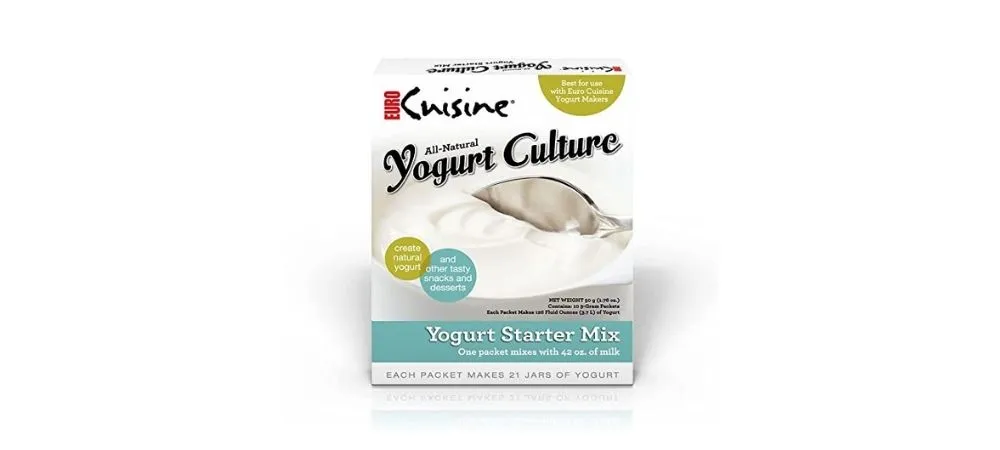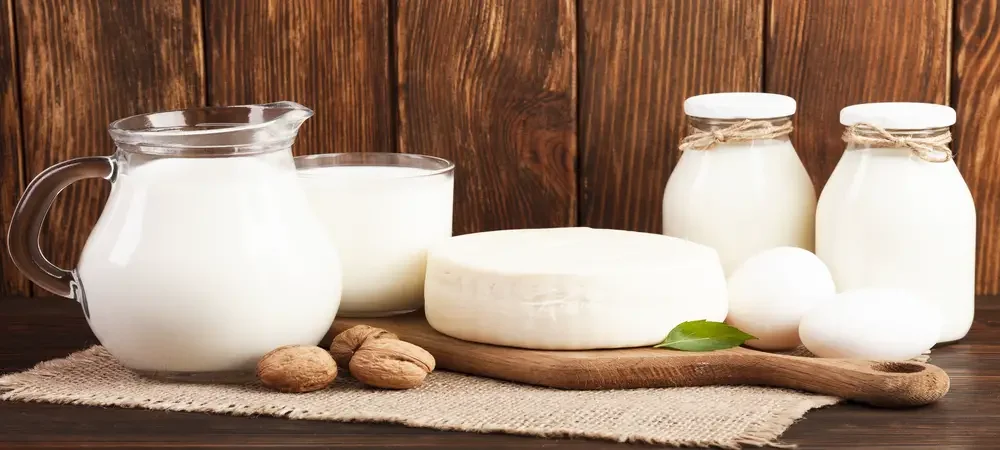Yogurt is a dairy product made by the bacterial fermentation of milk. The bacteria used to make yogurt are known as ‘yogurt cultures. Different yogurts ranging from sweetened fruit-flavored types to savory plain yogurts make it an appeasing appetizer and a healthy snack for many.
Related Posts:
- Grass Fed WHole Milk Cow’s Yogurt Vs. Coconut Yogurt – Which is Better?
- How To Make Smoothie Without Yogurt?
- What are the Substitutes of Yogurt?
- What Yogurt is Dairy-Free?
In this blog post, we will discuss the different types of yogurt available across the world. Let’s check out:
25 Types of Yogurts
Here are the 25 types of Yogurts:
1. Flavoured Yogurt

A range of fruit yogurts is available in the market, such as strawberry yogurt and mango yogurt, which can be eaten plain or with toppings like nuts or granola to add texture. In addition, there are many savory flavors, such as dill and chive, with a tangier taste.
2. Acidophilus Yogurt
This yogurt is a healthy bacteria that makes it easier for our body to absorb calcium. It is made by fermenting milk with Lactobacillus bulgaricus and Streptococcus thermophilus, two friendly bacteria found in the human intestinal tract. In yogurt, they ferment lactose to lactic acid. Thus, acidophilus yogurt contains less sugar and more protein than regular yogurts.
3. Live and Active Cultures Yogurt
Live and active culture yogurt is cultured milk characterized by its thick texture and tart taste. In some live and active cultures, yogurts have a milk protein called ‘whey’ added to give it a creamier texture. Whey is the watery part of milk that separates from curd while making cheese.
Related Posts:
- What is Aussie Style Yogurt?
- How to make Coconut Yogurt?
- How to strain Yogurt at home?
- Who invented yogurt?
4. Frozen Yogurt

Frozen yogurt, also known as ‘froyo,’ has become popular in recent years after being introduced in California in the 1970s. It is made by adding live cultures to milk and cream, then cooling the mixture to 40°F (4°C). The yogurt is churned during freezing to give it a light, soft texture similar to ice cream.
5. Kefir
Kefir is an effervescent drink that tastes slightly sour because of the lactic acid produced during fermentation. It is made by fermenting milk with yeast and kefir grains, a mixture of bacteria and yeasts in a matrix of proteins, lipids, and sugars. Kefir has more probiotic content than yogurt.
6. Soft Cheese
Soft cheese is a cheese that contains less fat than cream cheese or hard cheeses. It is crumbly with a mild, tangy flavor and high moisture content.
7. Cream Cheese
Cream cheese is made by adding cultures to heavy cream, allowing the mixture to ferment for 12 hours. Salt is added at the end of fermentation, and the cheese is then stored in a warm place for another 12 to 18 hours. It gives its distinctive flavor and texture, which is more solid than cream cheese but less dense than hard cheeses.
8. Dairy-Free Yogurt

Dairy-free yogurt can be made by fermenting soy milk, almond milk, or coconut milk with cultures instead of using dairy products.
9. Soy Yogurt
Soy yogurt is made by fermenting soy milk (made from ground soybeans), thicker than the almond or coconut milk used to make other dairy-free yogurts. The fermentation process causes it to have a mild, slightly sour taste similar to regular yogurt.
10. Homemade Yogurt
Homemade yogurt is a type of fermented milk that has a thickness and tartness similar to store-bought yogurts but with added fruit or other flavors. It can be made at home by adding live cultures yogurt to whole milk and allowing the mixture to ferment overnight in a warm place. However, you are not recommended to make your yogurt at home unless you are a microbial culturist.
11 Goat Milk Yogurt
Goat milk yogurt is made by fermenting goat’s milk with cultures instead of cow’s milk. Goat’s milk is lower in lactose than cow’s milk, so it needs to be fermented for a shorter amount of time. It has a thin texture and a tarter flavor that can taste similar to cheese.
12. Icelandic Yogurt
Icelandic yogurt is a type of cultured milk that is made by allowing unpasteurized milk to naturally ferment inside an Icelandic ‘gjáarkvåll’ for 12 hours. The fermentation process gives it a thicker texture and a more sour taste than regular yogurt due to lactic acid production. It can be made at home, but the fermentation process takes several days.
13. Kombucha Yogurt
Kombucha yogurt is made by adding kefir grains to kombucha (a fermented drink made by fermenting sweet tea) during the first or second fermentation period.
14. Grass-Fed Yogurt
Grass-fed yogurt is yogurt made with milk from grass-fed cows instead of conventional dairy farms. It tends to have a thicker consistency and a naturally sweeter flavor due to conjugated linoleic acid in its feed.
15. Lassi
Lassi refers to any beverage that has been mixed with fruit, vegetables, yogurt, buttermilk, or other dairy products. It is popular in South Asia, Southeast Asia, and the Caribbean Islands.
16. Kvass
Kvass is a Russian beverage usually made by fermenting rye bread or potatoes with yeast to produce a lightly fermented drink called ‘bread kvass.’ However, you can also ferment whey or fruit juice to make non-alcoholic versions.
17. Butter Milk

Buttermilk is the liquid that remains after churning butter out of cream, and it can be made with whole, low-fat, or skim milk. It has a thicker consistency than regular milk but tastes sourer due to the presence of lactic acid.
18 Australian Yogurt
Australian yogurt is a type of cultured milk that contains probiotics and has a texture similar to Greek yogurt. It is made by fermenting lactose-free Australian milk with live cultures for 18 hours, then adding thickening agents such as pectin or tapioca starch.
19. Pickled Yogurt
Pickled yogurt is a dairy product made by fermenting yogurt with lactic acid bacteria and other cultures for several months, which turns it into a pickle-like spread.
20. French-Style Yogurt
French-style yogurt is a type of cultured milk that takes on a yogurt-like texture due to the addition of rennet, which causes it to become partly solid. It usually tastes sour and has a custard-like consistency.
21. Unstrained cow’s Milk Yogurt
Unstrained yogurt is a type of fresh cow’s milk that is strained to remove the whey, which gives it a thicker consistency. It is commonly served with honey or fruit and nuts as part of breakfast or dessert. Unstrained yogurt does not contain much lactose, but it has higher concentrations of casein proteins than regular yogurt, which is why it is sometimes called casein.
22 Coconut Yogurt
Coconut yogurt is made by fermenting coconut milk with cultures to produce a thick, tart-tasting dairy product. You can make it at home by adding three tablespoons of unflavoured gelatine powder to one cup of warm coconut milk and allowing it to sit for about an hour before refrigerating.
23 Cashew Yogurt
Cashew yogurt is made by soaking cashews in water overnight before blending with cultures to make a creamy dairy product. It has a thicker texture than other nut yogurts and the rich flavor of cashews.
24 Yogurt Smoothie
A yogurt smoothie is a blended drink containing yogurt, fruit, ice cream, or sherbet. It is usually served as a dessert, snack, or breakfast item.
25 Tamarillo Yogurt
Tamarillo yogurt is made by fermenting tamarillos with cultures for several hours to create a tart-tasting dairy product. It looks and tastes similar to unstrained yogurt, but it has a higher sugar content than most other yogurts.
Frequently Asked Questions (FAQ)
1. What is the best yogurt?
The best yogurt is a type of cultured milk that contains live cultures and is known for its creamy texture and sweet taste. It can either be low-fat or full-fat, depending on your personal preference.
2. What are the health benefits of yogurt?
Yogurt offers several health benefits because it is a fermented dairy product made by adding Lactobacillus acidophilus and Bifid bacteria to milk. These cultures metabolize lactose in the milk, making it less harmful for lactose-intolerant people. As a result, yogurt helps improve digestion because these cultures produce lactic acid that stimulates healthy gut bacteria. Yogurt also has several other health benefits, including boosting the immune system, improving heart health, protecting against cancerous cell mutations, and promoting weight loss.
3. Are probiotics in yogurt healthy?
Yes, probiotics are healthy for your body because they improve gut function by allowing beneficial microorganisms to grow in the digestive tract. They are particularly helpful for preventing gastrointestinal problems such as diarrhea, bloating, and flatulence. However, not all yogurt products contain live cultures. Some shelf-stable yogurts have been heat-treated to kill the bacteria that produce lactic acid during fermentation, which means they do not offer any health benefits.
4. Is yogurt dairy?
Yogurt is dairy because it contains lactose, which is a sugar found in milk. Although yogurt tastes creamy and has a custard-like texture, it does not contain any lactose if the cultures used to ferment the milk metabolize all sugars.
5. Is yogurt bad for you?
No, yogurt is not bad for you, as long as you eat it in moderation. Full-fat yogurt is high in saturated fat, but low-fat yogurt is packed with sugar, making both types of yogurt less healthy. Unstrained yogurt may contain higher concentrations of casein proteins than regular yogurt and can cause digestive problems such as gas and bloating for some people.
6. What Type of Yogurt Has Most Probiotics?
Kefir is the best if you are seeking probiotics-rich yogurt. It normally contains 61 different strains of microbes. Kefir grains are used to ferment the milk which is a specific cluster of microbes.
7. Which Yogurt is Best For Inflammatory?
Studies suggest that Greek Yogurt is considered best as it has highest source of protein as compared to other counterparts yogurt.
8. What is the Difference Between Different Types of Yogurt?
Regular yogurt has more carbohydrates while the Greek Yogurt has more protein. Coming to Kefir, it is an excellent source of probiotics.











